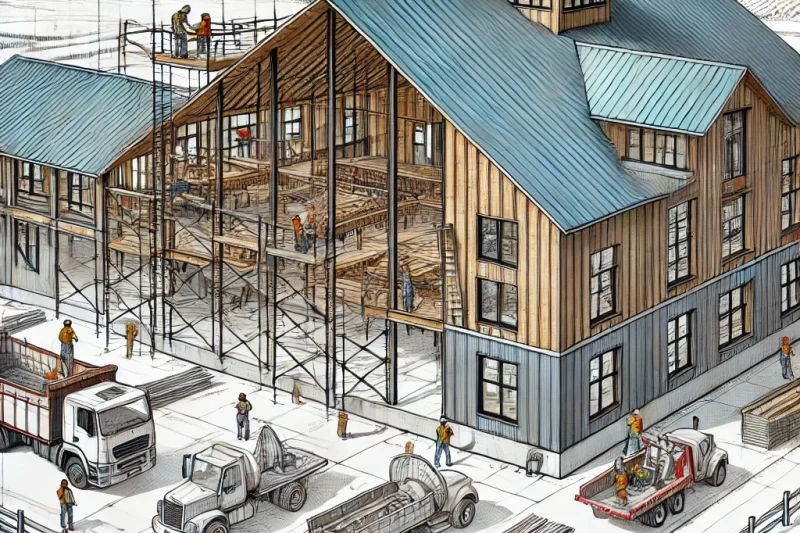Alaska USDA Loan Guide
“Unlock the Power of USDA Mortgages with Smart Mortgage!”
Alaska USDA Home Loan Guide
What is a Alaska USDA Mortgage?
Welcome to the Smart Mortgage guide on USDA Mortgages. Navigating the home financing world can be a daunting task, but understanding the various mortgage options available can significantly streamline the process. One such option that you might not be familiar with is the Alaska USDA mortgage. Let’s dive in.
1. Overview
A USDA mortgage, formally known as the USDA Rural Development Guaranteed Housing Loan, is a mortgage loan offered to rural property owners by the United States Department of Agriculture (USDA). Designed primarily to promote Alaska homeownership in rural and some suburban areas, the Alaska USDA loan comes with a range of benefits that make it a viable option for eligible homebuyers.
2. Key Features
- No Down Payment: One of the standout features of a USDA loan in Alaska is the possibility of financing up to 100% of the home’s price. This means eligible borrowers can buy Alaska home with no down payment.
- Competitive Interest Rates: Typically, USDA loans come with interest rates that are either at or below the market rate.
- Flexible Credit Guidelines: USDA loans often have more lenient credit requirements, which can be beneficial for those with a less than perfect credit history.
Alaska USDA Loan Questions Call (888)416-4805
Get cash from your home.
Apply to see how a cash out refinance can help you.
Homebuyer Seminars
Discover the keys to homeownership at our local home buying seminar – your first step towards securing your dream home!
See our home loans.
Explore our diverse range of home loan programs tailored to fit your unique needs!
3. Eligibility Criteria
To be eligible for a Alaska USDA mortgage, borrowers must meet certain requirements:
- Location: The Alaska property must be located in an eligible rural or certain suburban area as defined by the USDA.
- Income Limits: There are specific income requirements, both minimum and maximum, based on the median income of the area.
- Creditworthiness: While the USDA is generally more lenient with credit scores, a certain credit standard must still be met.
- Primary Residence: The borrower must occupy the home as their primary residence.
4. Benefits of a USDA Mortgage
- Affordability: With no down payment and the potential for lower mortgage insurance premiums, a Alaska USDA loan can be more affordable in the long run.
- Inclusive: It’s a great option for Alaska first-time homebuyers or those without a substantial savings for a down payment.
- Supporting Rural Development: By opting for a USDA mortgage, you’re indirectly supporting the development and sustainability of rural communities.
5. How Smart Mortgage Can Help
Navigating the intricacies of USDA mortgages in Alaska can be challenging. That’s where Smart Mortgage steps in. Our team of seasoned USDA mortgage professionals is here to guide you through every step, ensuring you make informed decisions tailored to your needs. Whether you have questions about your eligibility or the application process, we’re here to help.
Take the Next Step Interested in exploring if a Alaska USDA mortgage is right for you? Get in touch with our Smart Mortgage team today at (888)416-4805. We’re committed to helping you find the best mortgage solution for your unique situation.
Do you need a Pre-Approval?
We are here to help! Get a same day Alaska USDA pre-approval to shop for your dream home!
Mortgage Resource Center

USDA Loans in Illinois: Benefits, Eligibility, and Popular Cities
Buying a home is a significant milestone, and for many, finding the right loan program makes all the difference. If you're considering Read more
Barndominium Financing Made Easy with iLoanUSDA
Barndominium Financing Made Easy with iLoanUSDA: Your One-Time Construction Loan Solution Barndominiums, the stylish and practical combination Read moreMore information About Alaska
Alaska (/əˈlæskə/ ⓘ ə-LAS-kə) is a non-contiguous U.S. state on the northwest extremity of North America. It borders British Columbia and Yukon in Canada to the east and it shares a western maritime border in the Bering Strait with Russia’s Chukotka Autonomous Okrug. The Chukchi and Beaufort Seas of the Arctic Ocean lie to the north and the Pacific Ocean lies to the south. Technically a semi-exclave of the U.S., Alaska is the largest exclave in the world.
Alaska is the largest U.S. state by area, comprising more total area than the next three largest states of Texas, California and Montana combined, and is the seventh-largest subnational division in the world. It is the third-least populous and most sparsely populated U.S. state, but is, with a population of 736,081 as of 2020, the continent’s most populous territory located mostly north of the 60th parallel, with more than quadruple the combined populations of Northern Canada and Greenland. The state capital of Juneau is the second-largest city in the United States by area. The former capital of Alaska, Sitka, is the largest U.S. city by area. The state’s most populous city is Anchorage. Approximately half of Alaska’s residents live within the Anchorage metropolitan area.
Indigenous people have lived in Alaska for thousands of years, and it is widely believed that the region served as the entry point for the initial settlement of North America by way of the Bering land bridge. The Russian Empire was the first to actively colonize the area beginning in the 18th century, eventually establishing Russian America, which spanned most of the current state, and promoted and maintained a native Alaskan Creole population. The expense and logistical difficulty of maintaining this distant possession prompted its sale to the U.S. in 1867 for US$7.2 million (equivalent to $151 million in 2022). The area went through several administrative changes before becoming organized as a territory on May 11, 1912. It was admitted as the 49th state of the U.S. on January 3, 1959.
Abundant natural resources have enabled Alaska—with one of the smallest state economies—to have one of the highest per capita incomes, with commercial fishing, and the extraction of natural gas and oil, dominating Alaska’s economy. U.S. Armed Forces bases and tourism also contribute to the economy; more than half the state is federally-owned land containing national forests, national parks, and wildlife refuges. It is among the most irreligious states, one of the first to legalize recreational marijuana, and is known for its libertarian-leaning political culture, generally supporting the Republican Party in national elections. The Indigenous population of Alaska is proportionally the second highest of any U.S. state, at over 15 percent, after only Hawaii. Various Indigenous languages are spoken, and Alaskan Natives are influential in local and state politics.
The name “Alaska” (Russian: Аляска, romanized: Alyaska) was introduced in the Russian colonial period when it was used to refer to the Alaska Peninsula. It was derived from an Aleut-language idiom, alaxsxaq, meaning “the mainland” or, more literally, “the object towards which the action of the sea is directed”.
We Service the Following Areas



